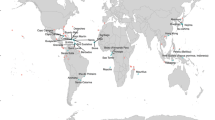Ten species of non-human primates are indigenous to Bioko; half of these are endangered and between five and eight are endemic subspecies. Recent data on their status and distribution have been lacking. In 1986, a ten-week survey of the island was carried out to determine the distribution and status of the primates and the natural vegetation, and to evaluate the effects of man on them. This paper presents the results of that survey, gives an update of conservation achievements since 1986, and highlights current concerns. Between 1974 and 1986 it is probable that numbers of all Bioko primates rose as a result of an increase in habitat and of reduced hunting. At the time of the survey there was considerably more natural, undisturbed, vegetation remaining in Bioko tran expected. Much of this vegetation occurs within two large blocks that are of outstanding importance to the conservation of species in tropical Africa, particularly of plants and primates.
Similar content being viewed by others
References
Alexander, B. (1903) On the birds of Fernando Po. Ibis, 303–403.
Amadon, D. (1953) Avian systematics and evolution in the Gulf of Guinea. Bull. Am. Mus. Nat. Hist. 100, 395–451.
Anon. (1969) Threat to monkeys on Fernando Po. Oryx 10, 146–7.
Butynski, T.M. (1984) Ecological survey of the Impenetrable (Bwindi) Forest, Uganda, and recommendations for its conservation and management. WWF Unpublished Report, Washington, DC.
Butynski, T.M. (1990) Comparative ecology of blue monkeys (Cercopithecus mitis) in high- and low-density subpopulations. Ecol. Monogr. 60, 1–26.
Butynski, T.M. and Koster, S.H. (1989) The status and conservation of forests and primates on Bioko Island (Fernando Poo), Equatorial Guinea. WWF Unpublished Report, Washington, DC.
Castro Antolin, M. (1985) Geografia de Guinea Ecuatorial. Madrid: Ministerio de Asuntos Exteriores.
Castroviejo, J., Juste, J. and Castelo, R. (1986) Proyecto de Investigacion y Conservation de la Naturaleza en Guinea Ecuatorial. Ministerio de Asuntos Exteriores, Espana, Secretaria de Estado para la Cooperacion Internacional y para Iberoamerica-Oficina de Cooperacion con Guinea Ecuatorial. Madrid: Secretaria General Tecnica.
Eisentraut, M. (1973) Die Wirbeltierfauna von Fernando Poo und Westkamerun. Bonner Zool. Monogr. 3, 1–428.
Fa, J.E. (1991) Conservacion de los Ecosistemas Forestales de Guinea Ecuatorial. Gland and Cambridge: IUCN.
Fa, J.E. (1992) Conservation in Equatorial Guinea. Oryx 26, 87–94.
Gadsby, E.L. and Jenkins, P.D. Jr. (1992) Wildlife and hunting in the proposed Etinde Forest Reserve. Unpublished Report to the Government of Cameroon.
Gartlan, J.S. (1970) Preliminary notes on the ecology and behavior of the drill Mandrillus leucophaeus, Ritgen, 1824. In Old World Monkeys: Evolution, Systematics and Behavior (J.R., Napier and P.H.Napier, eds) pp. 445–80. New York: Academic Press.
Gartlan, J.S. and Struhsaker, T.T. (1972) Polyspecific associations and niche separation of rainforest anthropoids in Cameroon, West Africa. J. Zool. 168, 221–66.
Gonzalez-Kirchner, J.P. (1990) Some data on the ecology of the drill (Papio leucophaeus) in the south of the island of Bioko (Republic of Equatorial Guinea). Unpublished Report, Universidad Complutense de Madrid.
Guinea, E. (1949) En el pais de los Bubis. Relato ilustrado de mi primer viaje a Fernando Poo. Madrid: Instituto de Estudios Africanos, Consejo Superior de Investigaciones Cientificas.
Jewell, P.A. and Oates, J. (1969) Ecological observations on the Lorisoid primates of African lowland forests. Zool. Afr. 4, 231–48.
Johnson, T.H., (1988) ICBP Island Database: Equatorial Guinea. Cambridge: ICBP.
Juste, J., Fa, J.E., Perez del Val, J. and Castroviejo, J. (0000) Market dynamics of bushmeat species in Equatorial Guinea. J. Appl. Ecol. in press.
Krumbiegel, I. (1943) Zur kenntnis der saugetierfauna von Fernando Poo. Arch. Naturgeschichte 4, 305–49.
Lee, P.C., Bennett, E. and Thornback, J. (1988) Threatened Primates of Africa. Cambridge: IUCN Species Monitoring Centre.
Mildbraed, J. (1922) Fernando Poo in Wissenschaftlicke Ergebnisse der Zweiten Deutschen Zentral-Africa-Expedition, 1910–11. Botanik, Leipzig 2, 164–95.
Oates, J.F. (1977) The guereza and man. In Primate Conservation (H.R.H.RainierIII and G.H. Bourne eds) pp. 419–67. New York: Academic Press.
Oates, J.F. (1986) Action plan for African primate conservation: 1986–1990. New York: IUCN/SSC Primate Specialist Group.
Oates, J.F. (1988) The distribution of Cercopithecus monkeys in West African forests. In A Primate Radiation (A.Gautier-Hion, F.Bourliere, J.-P.Gautier and J.Kingdon, eds) pp. 79–103. Cambridge: Cambridge University Press.
Sabater Pi, J. (1973) Contribution to the ecology of Colobus polykomos satanas (Waterhouse, 1838) of Rio Muni (Republic of Equatorial Guinea). folia primatol. 19, 193–207.
Sabater Pi, J. and Groves, C. (1972) The importance of higher primates in the diet of the Fang of Rio Muni. Man 7, 239–43.
Sabater Pi, J. and Jones, C. (1967) notes on the distribution and ecology of the higher primates of Rio Muni, West Africa. Tulane Stud. Zool. 14, 101–9.
Sanderson, I.T. (1940) The mammals of the North Cameroons forest area. Trans. Zool. Soc. Lond. 24, 623–725.
Schaaf, C.D., Butynski, T.M. and Hearn, G.W. (1990) The drill (Mandrillus leucophaeus) and other primates in the Gran Caldera Volcanica de Luba: Results of a survey conducted March 7–22, 1990. Zoo Atlanta Unpublished Report, Atlanta.
Struhsaker, T.T. (1969) Correlates of ecology and social organization among African cercopithecines. Folia Primatol. 11, 80–118.
Struhsaker, T.T. (1980) Comparison of the behaviour and ecology of red colobus and redtail monkeys in the Kibale Forest, Uganda. Afr. J. Ecol. 18, 33–51.
Struhsaker, T.T., Butynski, T.M. and Lwanga, J.S. (1988) Hybridization between redtail (Cercopithecus ascanius schmidti) and blue (C. mitis stuhlmanni) monkeys in the Kibale Forest, Uganda. In A Primate Radiation (A.Gautier-Hion, F.Bourliere, J.-P.Gautier and J.Kingdon, eds) pp. 477–97. Cambridge: Cambridge University Press.
Wolfheim, J.H. (1983) Primates of the World: Distribution, Abundance, and Conservation. Seattle: University of Washington Press.
Author information
Authors and Affiliations
Rights and permissions
About this article
Cite this article
Butynski, T.M., Koster, S.H. Distribution and conservation status of primates in Bioko island, Equatorial Guinea. Biodivers Conserv 3, 893–909 (1994). https://doi.org/10.1007/BF00129665
Received:
Accepted:
Issue Date:
DOI: https://doi.org/10.1007/BF00129665




